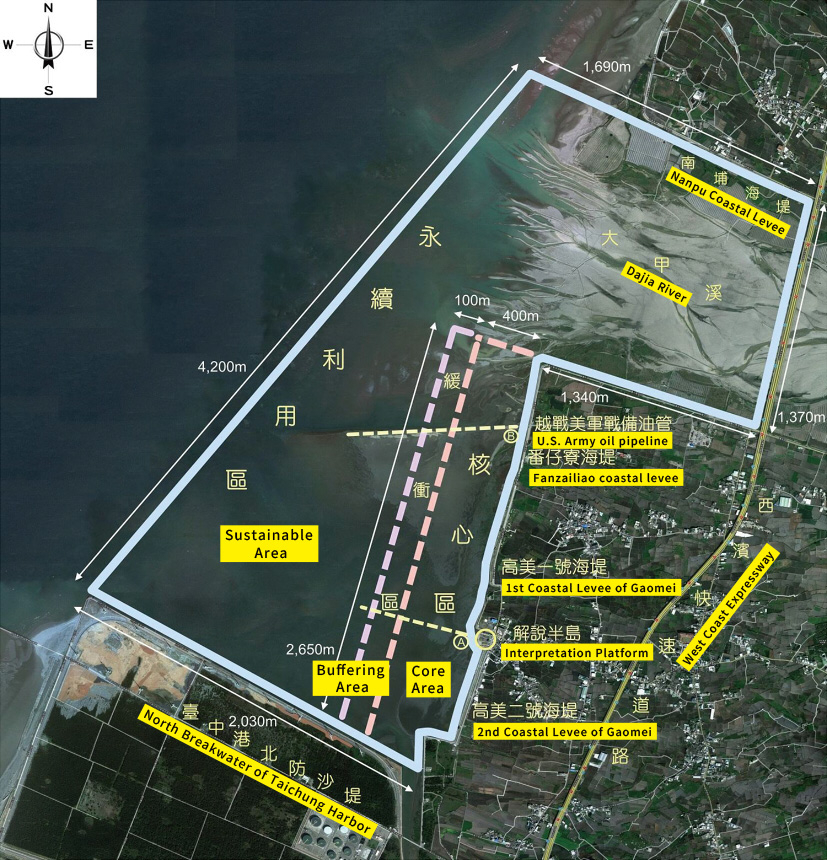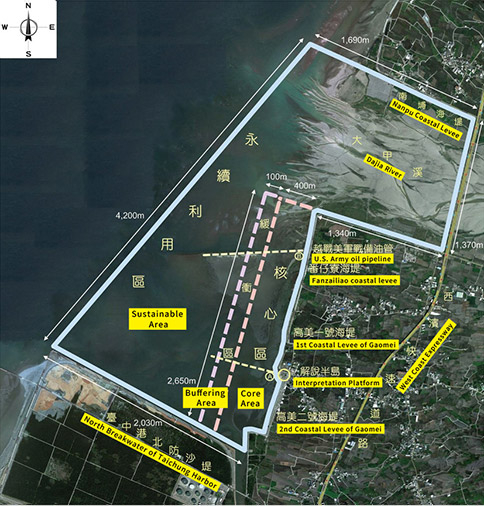
【Announcement】
1.Preservation Areas:
The north bound is the north bank of the Dajia River estuary, and the east bound is the west side of the West Coast Expressway toward south along the Qingshui District Coastal Dyke through the levee shoulder of Fanzailiao Coastal Levee, 1st and 2nd Levees of Gaomei toward west to the average low tide line, the south bound is the north breakwater of Taichung Harbor, with the area about 701.3 hectares (see details in the Conservation Plan and Area Map).
2.The Preservation Area Conservation Plan and Area Map will be displayed publicly for 30 days at the Taichung City Qingshui District Office and the Bulletin Board of this Government.
3. Areas of Preservation Area
(1) Core Area: The Core Area is defined as the areas with grass marshes extending 400 meters outward from Fanzailiao Coastal Levee, 1st and 2nd Coastal Levees of Gaomei, the areas without grass marshes extending from the 2nd Coastal Levee’s interpretation platform of Gaomei toward the Sustainable Area, and the oil pipeline (* Vietnam War US Army War Reserve Oil Pipeline areas) in Fanzailiao Coastal Levee are not included; the Core Area is about 105.2 hectares, accounting for 15% of total area of the Preservation Area.
(2) Buffering Area: The Buffering Area is defined as the area that extends 100 meters outward from the Core Area, the areas without grass marshes extending from the 2nd Coastal Levee’s interpretation platform of Gaomei toward the Sustainable Area, and the oil pipeline (* Vietnam War US Army War Reserve Oil Pipeline areas) in Fanzailiao Coastal Levee are not included; the Buffering Area is about 26.5 hectares, accounting for 3.78% of the total area of the Preservation Area.
(3) Sustainable Area: The remaining areas without grass marshes in the Preservation Area with the exception of the Core Area and the Buffering Area; the Sustainable Area is about 569.6 hectares, accounting for 81.22% of the total area of the Preservation Area.
4. Regulations
(1) Common regulations within preservation areas
- Actions disturbing, abusing, hunting, or killing wildlife, or damaging wildlife habitats are prohibited.
- Releasing or introducing wildlife is prohibited without prior approval from authorities.
- Collecting, cutting, or burning wildlife is prohibited without prior approval from authorities.
- Deliberate trampling or digging of plants, littering, dumping trash or waste soil, placing illegal constructions, discharging wastewater, and other actions incurring environmental damage are prohibited.
- Activities including developing, farming, building, excessive logging, illegal burying, collecting rocks or minerals, and other actions that may lead to environmental damage are prohibited. The authorities may provide necessary facilities for habitat improvement, restoration, conservation, that is permitted under the circumstances of minimal damage or disturbance to major habitats and wildlife.
- Any economic activities in preservation areas should remain governed by their original state of legal use and are to be conducted according to related laws and regulations.
- Businesses involving use of water resources in river or seawall regions should be governed by authorities regarding water resources according to the Water Act, the Wildlife Conservation Act, and other related regulations.
- Local domiciled fishermen are allowed to conduct existing agricultural or fishery activities inside preservation areas (except for the core area) under the condition of not violating preservation area regulations.
- Except for existing fishery-related purposes, vehicles and machines are prohibited from entering preservation areas without permission from the authorities or commissioned organizations.
- Individuals who need enter preservation areas to collect wildlife for academic, educational or research purposes should first be approved by the authorities. Approval documentation and identification documents should be available for inspection upon arrival.
- Other regulations based on the Wildlife Conservation Act and related laws also apply.
(2) Regulations in the core area
Entry to this area is prohibited without permission from the authorities. Authorities with access to seawalls are only allowed to enter the region within 50 meters outside the seawall for flood control or repair purposes.
(3) Regulations in the buffering area
The regions open for permitted access, opening hours, and other regulations in this area are to be announced by the authorities. Beach cleanup, nature photography, ecotourism, visitation, or other activities are allowed in this area during opening hours with permission from the authorities. Other activities are prohibited without permission from the authorities.
(4) Regulations in the sustainable area
- The regions open for permitted access, opening hours, and other regulations in this area are to be announced by the authorities.
- The authorities may open this area to tourists for visitation. Swimming, snorkeling, activities requiring assisting equipment, such as SCUBA diving, or other aquatic recreational activities announced by the authorities are prohibited in this area.
5. Penalties
- Violators of the regulations mentioned above are subjected to be fined from NT$20,000 to NT$100,000 for disturbing and abusing wildlife, and from NT$50,000 to NT$250,000 for hunting and killing wildlife according to Article 50 of the Wildlife Conservation Act.
- Illegal hunting or killing of a Protected Wildlife species shall be punished with imprisonment for no less than six months and no more than five years, and/or a fine of no less than NT$200,000 and no more than NT$1,000,000 according to Article 41 of Wildlife Conservation Act.
- Illegal disturbance or abuse of the Protected Wildlife shall be punished with imprisonment for no more than one year; detention; and/or a fine of no less than NT$60,000 and no more than NT$300,000; if the conducts cause the death of protected species, the offender shall be punished with imprisonment for no more than two years, detention, and/or a fine of no less than NT$100,000 and no more than NT$500,000 according to Article 42 of Wildlife Conservation Act.
- If any of the above offenses are committed in the Wildlife Refuge, the offender shall be subjected to the penalty prescribed for such offense up to 1/3 according to Article 41 and 42 of Wildlife Conservation Act.
▶ The regulations and areas of Gaomei Wetland Preservation Area announcement (Mandarin Version)
▶ Guidance for Applying Entry Permit Into the Gaomei Wetland Preservation Area (Mandarin Version)
▶ Wildlife Conservation Act

